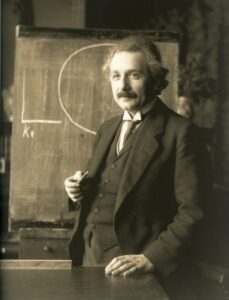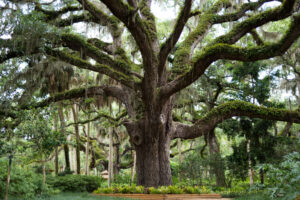Darwinian Evolution
The theory of Charles Darwin, known as Darwinian evolution or the theory of natural selection, revolutionized our understanding of life on Earth. Darwin’s theory explains how all species, including humans, have evolved over time from a common ancestor through a process called descent with modification.
 Pin
Pin Darwin’s theory was first introduced in his groundbreaking book, “On the Origin of Species,” published in 1859. In this book, he outlined the evidence and mechanisms behind his theory, which challenged religious and scientific beliefs at the time.
One of the key concepts in Darwin’s theory is the idea of natural selection. Natural selection is the process by which nature selects the fittest individuals within a population to survive and reproduce, while less fit individuals are less likely to pass on their genes. This leads to the gradual accumulation of favorable traits in a population over successive generations.
According to Darwin, natural selection occurs due to variation within a population. No two individuals are exactly the same; they differ in traits such as size, coloration, or behavior. Some traits may be advantageous in a particular environment, while others may be detrimental. Individuals with advantageous traits are more likely to survive, reproduce, and pass on their genes to the next generation. Over time, this can lead to the evolution of new species.
Another important aspect of Darwin’s theory is the concept of common descent. He proposed that all organisms, from bacteria to plants to humans, share a common ancestral species. This means that all life on Earth is interconnected through a vast network of evolutionary relationships.
Darwin’s theory is supported by a large body of evidence from various fields of study. Fossils, for example, provide a record of past life forms and their evolution over time. The fossil record shows a clear progression of species, with more complex forms appearing in more recent layers.
Comparative anatomy is another line of evidence for Darwin’s theory. By studying the similarities and differences in the structure of different organisms, scientists can uncover their evolutionary relationships. For example, the pentadactyl limb, found in mammals from bats to whales to humans, suggests a common ancestor with a five-fingered limb.
Another powerful evidence for Darwin’s theory is the presence of vestigial structures. These are organs or structures that have no functional use in an organism. For example, the human appendix is believed to be a vestigial structure that was once used for digestion in our ancestors. These vestigial structures can be understood as remnants of evolutionary history.
Furthermore, the field of genetics has provided strong support for Darwin’s theory. The discovery of DNA and the understanding of how genes are inherited has revealed the mechanisms behind evolutionary change. By studying mutations and gene frequencies within populations, scientists can track the genetic changes that occur over time.
Despite its strong evidential support, Darwin’s theory has faced criticism and controversy. Some religious groups, for example, have rejected the idea of evolution on religious grounds. Other scientists have proposed alternative theories, or modifications to Darwin’s theory, to better explain certain aspects of evolution.
However, the theory of Charles Darwin remains the prevailing explanation for the diversity of life on Earth. It has profoundly influenced fields such as biology, paleontology, and genetics, and continues to shape our understanding of the natural world. Darwin’s theory provides a framework for studying and explaining the incredible complexity and beauty of life on our planet.
 Pin
Pin Charles Darwin's Voyage
Charles Darwin developed his theory of natural selection through observations, comparisons, and deductions based on his experiences during his five-year journey on the HMS Beagle (1831-1836) and subsequent studies.
During his voyage, Darwin made numerous observations on the Galapagos Islands, specifically studying the variation among the finches. He noticed that the finches had different beak shapes and sizes, which he attributed to the availability of different food sources on each island. This led him to consider the idea that species could adapt to their environment.
Darwin also observed similarities and differences among species in different regions. For example, he noticed that species in South America were similar to those on the Galapagos Islands, with slight variations. This suggested a common ancestry and the possibility that species changed over time.
Upon his return to England, Darwin started studying and collecting various organisms and their characteristics. He realized that species often produced more offspring than could survive, leading to competition for resources.
Drawing inspiration from Thomas Malthus’ work on population growth, Darwin concluded that organisms with advantageous traits would have a higher chance of survival and reproduction. Those traits would then be passed on to the next generation, leading to an accumulation of favorable characteristics over time, while less favorable traits would diminish.
To support his ideas, Darwin collected a substantial amount of evidence from various fields. He examined fossil records, which revealed the existence of extinct species and transitional forms. These fossils indicated that current species were not static but had evolved from earlier forms.
Darwin also studied the breeding of domesticated plants and animals. He observed that selective breeding could lead to the development of new breeds with desired traits. By extrapolating this concept to natural conditions, he proposed that a similar process could be occurring in the natural world.
Additionally, Darwin was influenced by the work of other naturalists, such as Alfred Russel Wallace, who independently developed similar theories.
In 1859, Darwin published his landmark book “On the Origin of Species,” where he presented his theory of natural selection. Though met with initial skepticism, his theory was gradually accepted and revolutionized our understanding of the origin and diversification of species.
 Pin
Pin Although Charles Darwin was an unpromising schoolboy and student, his family decided he should be a doctor. But he was far too squeamish for the blood and horrors of 19th century medicine, and so after a miserable time studying medicine at Edinburgh, his father sent him to Cambridge to study theology (religion). This didn’t interest him much either, but while there he attended the lectures in botany given by the botany professor (below), J. S. Henslowe.
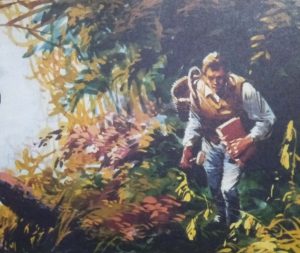 Pin
Pin In 1831, his big chance came. The little HMS Beagle was going on a five-year cruise to chart the coast and islands of South America, the Pacific, New Zealand and Australia. It was decided that it would be useful to take along a naturalist to study any interesting plants and animals that were found. Henslowe put forward Darwin’s name, and the 22-year-old landlubber found himself aboard the tiny 24-tonne ship.
The voyage was to be a turning point in Darwin’s life. The observations made on the trip were to help formulate a theory that would anger the world.
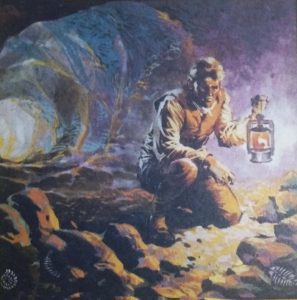 Pin
Pin The young naturalist enjoyed ‘geologizing’, as he called it, and would leap ashore at every opportunity and scramble among the thickets and over boulders to collect samples. His careful study of rocks convinced him of the truth of the assertion made by the geologist Charles Lyell in his book Principles of Geology that the Earth was far older than 4004 B.C. — the age of creation as calculated from a factual reading of the Bible. Darwin also discovered the fossilised remains of some prehistoric creatures in a cave in Patagonia, South America. Why had the Creator made such wonderful creatures if only to let them die out in a great catastrophe like the Great Flood in the Bible?
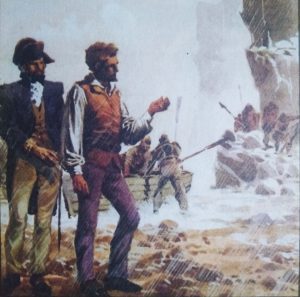 Pin
Pin Many months were spent along the bleak, cheerless coast of Tierra del Fuego, the large island off the southernmost tip of South America. But even here Darwin made good use of his time, collecting specimens of plants and pressing them as shown by Professor Henslowe.
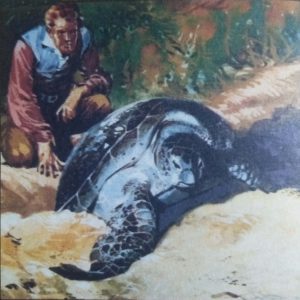 Pin
Pin As the Beagle travelled round South America and on into the Pacific, Darwin collected rocks and shells, bones and fossils, as well as plants. He began to notice how the same kind of creature, a chaffinch for example, would vary slightly from region to region. He noticed this especially on the Galapagos Islands in mid-Pacific, and made a close study of the giant tortoises there. Why was each type of tortoise a little bit different on each island?
 Pin
Pin The naturalist of the Beagle was beginning to formulate a theory about these different variations or species, although he had little time to work out his ideas. The expedition was busy — and dangerous too at times. Once Darwin witnessed the effects of an earthquake that wrecked the city of Concepcion.
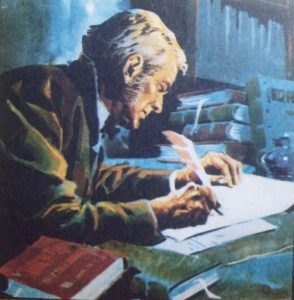 Pin
Pin In all, the voyage lasted for five years, ending in 1836. But 23 years passed before Darwin published his famous book The Origin of Species, based largely on his observations during his world cruise. In The Origin he explained his belief that all the living things in the world today have developed gradually through millions of years from strange and extinct ancestors. Even man, somewhere in the mists of time, shares a common ancestor with the modern ape.
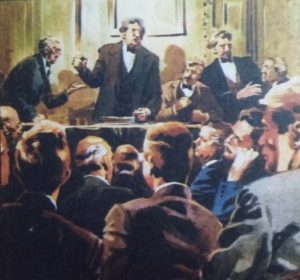 Pin
Pin Darwin’s book made many people angry because they thought his ideas were against the teaching of the Bible. There were many furious arguments between learned men who supported Darwin and those who did not. Darwin suffered ill-health (probably a disease he contracted while in South America) for most of his life and he did not join in the disputes. He lived quietly in the country at Downe, in Kent with his wife and children. When the arguments died down, few people still doubted that life in all its forms had evolved slowly as Darwin had stated. The study of biology — and of Man as one of the animals — was revolutionised.
 Pin
Pin Charles Darwin's theory of natural selection, as presented in his groundbreaking book "On the Origin of Species," challenged both religious and scientific beliefs of his time and had significant social and cultural impacts.
-
Religious Beliefs
- Creationism: Prior to Darwin’s theory, the dominant religious belief was that God created all species in their present form, as described in various religious texts. Darwin’s theory directly contradicted this belief by proposing that species evolved over time through a process of natural selection, without the direct intervention of a divine creator.
- Biblical Literalism: Many people at that time adhered to a literal interpretation of the Bible, which meant that they believed in the literal truth of the Genesis account of creation. Darwin’s theory undermined this literal interpretation, casting doubt on the idea that the Earth was only a few thousand years old and challenging the concept of a static, unchanging world.
CopiedReligious Beliefs- Creationism: Prior to Darwin's theory, the dominant religious belief was that God created all species in their present form, as described in various religious texts. Darwin's theory directly contradicted this belief by proposing that species evolved over time through a process of natural selection, without the direct intervention of a divine creator.
- Biblical Literalism: Many people at that time adhered to a literal interpretation of the Bible, which meant that they believed in the literal truth of the Genesis account of creation. Darwin's theory undermined this literal interpretation, casting doubt on the idea that the Earth was only a few thousand years old and challenging the concept of a static, unchanging world.
-
Scientific Beliefs
- Fixity of Species: The prevailing scientific belief before Darwin was that species were fixed and unchanging. Darwin’s theory of natural selection proposed that species were not fixed entities but instead underwent gradual changes over time. This idea was revolutionary and challenged the scientific consensus of his time.
- Paleontology: Darwin’s theory provided a framework for understanding the abundant fossil record. It explained the emergence and disappearance of different species over time, filling gaps in the understanding of paleontology and offering a more coherent explanation for the diversity of life.
CopiedScientific Beliefs- Fixity of Species: The prevailing scientific belief before Darwin was that species were fixed and unchanging. Darwin's theory of natural selection proposed that species were not fixed entities but instead underwent gradual changes over time. This idea was revolutionary and challenged the scientific consensus of his time.
- Paleontology: Darwin's theory provided a framework for understanding the abundant fossil record. It explained the emergence and disappearance of different species over time, filling gaps in the understanding of paleontology and offering a more coherent explanation for the diversity of life.
Social and Cultural Impacts:
Controversy and Debate
Copied
Controversy and Debate
Darwin's theory sparked significant controversy and debate within both religious and scientific communities. Many theologians and religious organizations condemned Darwin's ideas, fearing they undermined religious authority and doctrines. This led to confrontations, such as the famous Scopes Monkey Trial in the United States in 1925, where the teaching of evolution was put on trial.
Darwin's theory sparked significant controversy and debate within both religious and scientific communities. Many theologians and religious organizations condemned Darwin's ideas, fearing they undermined religious authority and doctrines. This led to confrontations, such as the famous Scopes Monkey Trial in the United States in 1925, where the teaching of evolution was put on trial.
Darwin’s theory sparked significant controversy and debate within both religious and scientific communities. Many theologians and religious organizations condemned Darwin’s ideas, fearing they undermined religious authority and doctrines. This led to confrontations, such as the famous Scopes Monkey Trial in the United States in 1925, where the teaching of evolution was put on trial.
Secularization
Copied
Secularization
In some parts of society, Darwin's theory contributed to the growing secularization and separation of science from religion. It challenged the influence and authority of religious institutions in explaining the natural world, leading to a greater emphasis on scientific methodology and empirical evidence.
In some parts of society, Darwin's theory contributed to the growing secularization and separation of science from religion. It challenged the influence and authority of religious institutions in explaining the natural world, leading to a greater emphasis on scientific methodology and empirical evidence.
In some parts of society, Darwin’s theory contributed to the growing secularization and separation of science from religion. It challenged the influence and authority of religious institutions in explaining the natural world, leading to a greater emphasis on scientific methodology and empirical evidence.
Impact on Literature and Art
Copied
Impact on Literature and Art
Darwin's theory impacted various forms of artistic expression, including literature and painting. It inspired authors like H.G. Wells and Thomas Hardy to explore themes of evolution and natural selection. In art, there was a shift towards depicting the natural world in more realistic and scientifically accurate ways.
Darwin's theory impacted various forms of artistic expression, including literature and painting. It inspired authors like H.G. Wells and Thomas Hardy to explore themes of evolution and natural selection. In art, there was a shift towards depicting the natural world in more realistic and scientifically accurate ways.
Darwin’s theory impacted various forms of artistic expression, including literature and painting. It inspired authors like H.G. Wells and Thomas Hardy to explore themes of evolution and natural selection. In art, there was a shift towards depicting the natural world in more realistic and scientifically accurate ways.
Ethical and Social Implications
Copied
Ethical and Social Implications
Darwin's theory raised ethical and social questions, including its potential application to human societies. The concept of natural selection led to the theory of social Darwinism, which applied ideas of "survival of the fittest" to human societies. This interpretation sparked debates about eugenics, colonialism, and the treatment of marginalized groups.
Darwin's theory raised ethical and social questions, including its potential application to human societies. The concept of natural selection led to the theory of social Darwinism, which applied ideas of "survival of the fittest" to human societies. This interpretation sparked debates about eugenics, colonialism, and the treatment of marginalized groups.
Darwin’s theory raised ethical and social questions, including its potential application to human societies. The concept of natural selection led to the theory of social Darwinism, which applied ideas of “survival of the fittest” to human societies. This interpretation sparked debates about eugenics, colonialism, and the treatment of marginalized groups.
Darwin’s theory of natural selection challenged religious beliefs by contradicting the idea of divine creation and undermined existing scientific beliefs by proposing that species were not fixed. Its social and cultural impacts included controversy and debate, secularization, influence on artistic expression, and ethical and social implications.
Charles Darwin gathered evidence and made several observations to support his theory of evolution. These include:
-
01
Fossil Record
Darwin noted that the fossil record revealed a pattern of simple life forms in the oldest rock layers, gradually becoming more complex in the younger layers. He argued that this sequential arrangement indicated a historical progression of life, supporting the idea of common descent and gradual changes over time.
CopiedFossil RecordDarwin noted that the fossil record revealed a pattern of simple life forms in the oldest rock layers, gradually becoming more complex in the younger layers. He argued that this sequential arrangement indicated a historical progression of life, supporting the idea of common descent and gradual changes over time.
-
02
Comparative Anatomy
Darwin observed that different species often shared similar anatomical structures, suggesting a common ancestry. For example, the presence of similar bone structures in the limbs of mammals, birds, and reptiles indicated a shared evolutionary history. Additionally, the observation of vestigial organs, such as the appendix in humans, suggested that these structures had once served a function in ancestral organisms but were now reduced or non-functional.
CopiedComparative AnatomyDarwin observed that different species often shared similar anatomical structures, suggesting a common ancestry. For example, the presence of similar bone structures in the limbs of mammals, birds, and reptiles indicated a shared evolutionary history. Additionally, the observation of vestigial organs, such as the appendix in humans, suggested that these structures had once served a function in ancestral organisms but were now reduced or non-functional.
-
03
Embryology
Darwin noticed similarities in the early stages of development among different species. For instance, the embryos of mammals, birds, and reptiles all display gill slits and tails during certain stages, suggesting a shared evolutionary history.
-
04
Biogeography
Darwin studied the distribution of plants and animals in various regions and found that similar environments often boasted distinct but related species. This observation provided support for the idea of species evolving differently in response to different conditions and geographical separation.
CopiedBiogeographyDarwin studied the distribution of plants and animals in various regions and found that similar environments often boasted distinct but related species. This observation provided support for the idea of species evolving differently in response to different conditions and geographical separation.
-
05
Adaptive Traits
Darwin observed variations within populations and noted that certain traits provided advantages for survival and reproduction in specific environments, a concept he termed “natural selection.” For instance, he studied the beak shapes of finches on the Galapagos Islands and found that variations in beak size and shape allowed different species to specialize in eating different food sources.
CopiedAdaptive TraitsDarwin observed variations within populations and noted that certain traits provided advantages for survival and reproduction in specific environments, a concept he termed "natural selection." For instance, he studied the beak shapes of finches on the Galapagos Islands and found that variations in beak size and shape allowed different species to specialize in eating different food sources.
-
06
Artificial Selection
Darwin noticed that humans could deliberately influence the traits of domesticated plants and animals through selective breeding. He used this observation to argue that natural selection operates similarly in wild populations, with advantageous traits becoming more common over time.
CopiedArtificial SelectionDarwin noticed that humans could deliberately influence the traits of domesticated plants and animals through selective breeding. He used this observation to argue that natural selection operates similarly in wild populations, with advantageous traits becoming more common over time.
These evidences and observations formed the basis of Darwin’s theory of evolution and supported the idea that species change over time through gradual modifications, adapt to their environments, and that all living organisms share a common ancestry.
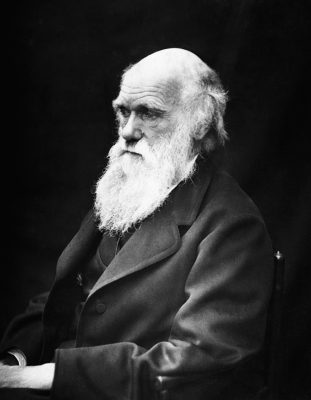 Pin
Pin Charles Robert Darwin
Charles Robert Darwin was an English naturalist, geologist, and biologist. He was born on February 12, 1809, in the picturesque market town of Shrewsbury, Shropshire, England. He came from a wealthy and well-established family and was the fifth of six children. His father, Robert Waring Darwin, was a successful physician, and his mother, Susannah Darwin, came from the Wedgwood family, known for their pottery.
From a young age, Darwin showed a deep curiosity and fascination with nature. He spent his childhood exploring the countryside, collecting plants, insects, and rocks. He had a particular affinity for beetles and became an avid beetle collector. Despite being sent to a prestigious boarding school, Darwin did not excel academically but developed a keen interest in natural history.
In 1825, at the age of 16, Darwin began studying medicine at the University of Edinburgh, following in his father’s footsteps. However, he soon realized that his true passion lay in natural sciences. Two years later, he transferred to the University of Cambridge to study theology and natural sciences. His time there had a profound impact on him, and he was influential in the formation of the Cambridge Apostles, an intellectual society.
After completing his studies at Cambridge, Darwin had the opportunity to embark on a self-funded voyage aboard HMS Beagle as an unremarkable naturalist. The Beagle was tasked with conducting hydrographic surveys of the coast of South America, and during the five-year journey, Darwin would explore and collect specimens in various locations such as the Galapagos Islands, Tierra del Fuego, and Brazil.
It was during this voyage that Darwin began to develop his ideas on evolution and natural selection. He observed the vast diversity of plant and animal life, noticing variations within species and their suitability to their environment. This experience led him to question the prevailing belief in the fixity of species, and he started to formulate his groundbreaking theory of evolution.
Upon his return to England in 1836, Darwin began meticulously cataloging, categorizing, and studying the specimens he had collected. He also started corresponding with prominent scientists, such as Charles Lyell and Joseph Hooker, sharing his observations and ideas. This process of analysis and collaboration would continue for many years, eventually resulting in his seminal work, “On the Origin of Species by Means of Natural Selection,” published in 1859.
Darwin’s book introduced the concept of natural selection as the driving force behind the evolution of species. He argued that organisms with inherited traits favorable for survival and reproduction would be more likely to pass those traits onto the next generation. Over long periods of time, these accumulated advantageous traits would result in the development of new species.
Despite its controversial nature, Darwin’s theory of evolution revolutionized the scientific community’s understanding of life on Earth. It had far-reaching implications for fields beyond biology and challenged deeply ingrained religious beliefs. Darwin’s work sparked intense debates and remains influential to this day, shaping the study of biodiversity, paleontology, genetics, and human evolution.
Later in life, Darwin continued his scientific research, focusing on topics such as the expression of emotions in humans and animals, earthworm behavior, and orchid pollination. He lived a relatively secluded life in Down House, Kent, where he conducted experiments and wrote prolifically, publishing numerous other books.
Charles Darwin died on April 19, 1882, at the age of 73, leaving behind an enduring legacy as one of the most influential scientists in history. His ideas continue to shape our understanding of the natural world, and his passion for observation, inquiry, and critical thinking remains an inspiration for generations of scientists to come.
Frequently Asked Questions "The theory of Charles Darwin" :
Charles Darwin was a British naturalist and biologist, born on February 12, 1809, and who lived until April 19, 1882. He is famous for his contributions to the theory of evolution through his groundbreaking work “On the Origin of Species.”
“On the Origin of Species” is a book written by Charles Darwin in 1859. It is considered one of the most influential works in the fields of biology and natural sciences. In this book, Darwin introduced the concept of natural selection, which revolutionized the understanding of how species evolve over time.
Natural selection is the mechanism proposed by Charles Darwin to explain the process through which species evolve and adapt to their environment. According to this theory, individuals with favorable traits that better suit their environment are more likely to survive and reproduce, passing on those advantageous traits to their offspring. Over time, this leads to the gradual evolution of species.
Darwin gathered extensive evidence from various sources to support his theory of evolution. He studied fossils, comparing them to living species, and observed variation in plants and animals during his travels aboard the HMS Beagle. He also noticed how species are well-suited to their specific environments. This collection of evidence formed the basis for his argument in favor of evolution through natural selection.
No, Darwin was not the first to propose the idea of evolution. The concept of species transforming over time had been suggested by earlier scholars, including Jean-Baptiste Lamarck and Alfred Russel Wallace. However, Darwin’s contribution was the development of the theory of natural selection, which provided a mechanism for the process of evolution.
Yes, Darwin’s theory of evolution faced significant opposition, particularly from religious groups and other scientists who disagreed with his ideas. Some argued that his theory contradicted religious beliefs, while others questioned the scientific evidence supporting evolution. However, over time, the theory of evolution gained wider acceptance and is now a fundamental concept in the field of biology.
Charles Darwin’s theory of evolution had a profound impact on scientific thought and the understanding of the natural world. It revolutionized biology, providing a comprehensive explanation for the diversity of life on Earth. It also influenced fields such as anthropology, psychology, and medicine. Additionally, Darwin’s work laid the foundation for future scientific discoveries and continues to drive research in evolutionary biology.
Aside from his contributions to the theory of evolution, Charles Darwin made significant contributions to other scientific fields. He wrote extensively on topics such as geology, paleontology, botany, and zoology. His studies on earthworms, barnacles, and orchids, among others, provided valuable insights into their biology and behavior.
Charles Darwin’s legacy is far-reaching and enduring. His theories and ideas continue to shape scientific thought, particularly in the fields of biology and evolutionary studies. His work also had a profound impact on society, challenging traditional beliefs and sparking debates about the relationship between science and religion. Darwin’s legacy can be seen in the ongoing research and exploration of the natural world, as well as the widespread acceptance of the theory of evolution.

























